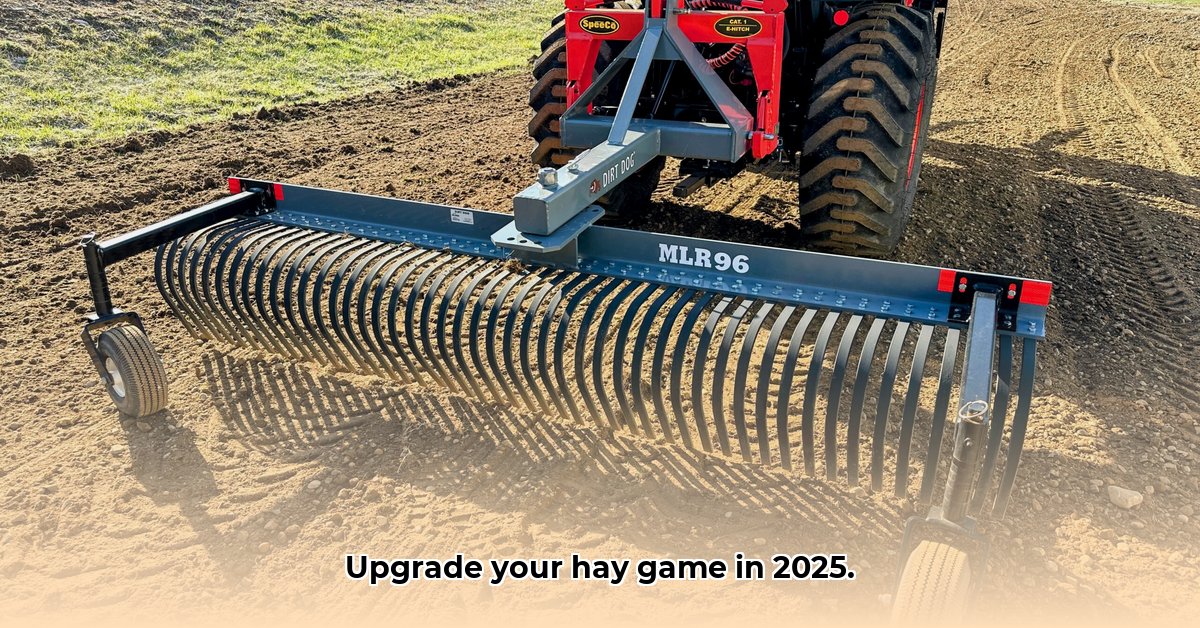
Rake Attachment for Tractor: Your 2025 Buyer's Guide
Choosing the right tractor landscape rake attachment significantly impacts farming efficiency and sustainability. This guide helps you select the perfect rake for your needs, covering various types, key features, brand comparisons, and operational considerations. We’ll also discuss the environmental impact and highlight how choosing a durable rake contributes to sustainable agriculture. For more detailed specs, check out this helpful tractor rake resource.
Figuring Out What You Need: Matching the Rake to the Job
Before exploring specific rakes, define your primary application. Will you primarily use it for land clearing after a storm or logging operation? Preparing seedbeds for planting? Smoothing uneven terrain? The ideal rake directly correlates with your specific needs. Don't assume a larger or more expensive rake is inherently better; a smaller, well-suited model will be more productive and cost-effective in the long run. What are your top three priorities when it comes to choosing a landscape rake for sustainability, and how do these impact your selection process?
Different Types of Tractor Rakes: A Detailed Overview
Several rake types cater to diverse applications. Each offers unique advantages and disadvantages.
Spring-Tine Rakes: These gentler rakes excel at collecting light debris and preparing delicate seedbeds. Their flexible tines minimize soil disturbance. However, they are unsuitable for heavy-duty land clearing.
Rigid-Tine Rakes: Built for robust tasks, these rakes efficiently handle heavier debris and leveling uneven ground. Their strength comes at the cost of potentially greater soil compaction if not used carefully.
Rotary Rakes: Employing rotating drums or tines, they are well-suited for high-capacity tasks like hay gathering. However, they lack the precision needed for detailed land preparation.
Landscape Rakes: Designed for landscaping and fine grading, they offer precise control for smaller projects. Their capacity is generally lower than other rake types.
| Rake Type | Best Use | Advantages | Disadvantages |
|---|---|---|---|
| Spring-Tine | Light debris, seedbed prep | Gentle on soil, excellent ground following | Ineffective for heavy debris |
| Rigid-Tine | Heavy debris, leveling | High durability, effective for tough materials | Can compact soil, less precise |
| Rotary Rake | Hay gathering, large material removal | High capacity, fast operation | Less precise for land preparation |
| Landscape Rake | Landscaping, fine grading, small projects | Versatile, precise control | Lower capacity than other rake types |
Key Features to Consider Before Purchasing
Several critical features directly impact performance, durability, and longevity.
Tine Material and Construction: High-carbon steel tines provide superior durability and resistance to wear. Consider the type of material you'll be raking. Stronger tines are essential for handling rocks and heavy debris.
Working Width: Select a working width compatible with your tractor's horsepower and the size of your working area. A wider rake covers more ground faster, but excessive width can reduce maneuverability.
Gauge Wheels: Crucial for maintaining uniform depth and level grading, gauge wheels ensure consistent results and prevent soil gouging. Adjustable gauge wheels allow for greater precision.
Hitch Type: Confirm compatibility with your tractor's three-point hitch system. The hitch type and capacity must match the rake's specifications.
Maintenance Requirements: Consider ease of maintenance, parts availability, and anticipated long-term maintenance costs. Regular lubrication and timely tine replacement are crucial for optimal performance and extended lifespan.
Brand Comparison: A Cautious Overview
Several reputable brands manufacture tractor landscape rake attachments, including Woods, Leinbach, Rockhound, and Everything Attachments. However, comprehensive comparative testing data is limited. Thorough research of individual models, reading user reviews, and seeking advice from other farmers are crucial for making an informed decision. Is there a particular brand that consistently receives high praise for its durability and ease of maintenance in your region?
Choosing Your Rake: A Step-by-Step Decision-Making Process
Define Your Needs: Identify your primary applications (land clearing, seedbed preparation, etc.).
Establish Your Budget: Set a realistic budget that encompasses the initial purchase price and anticipated maintenance costs.
Select the Rake Type: Choose a rake type (spring-tine, rigid-tine, rotary, or landscape) based on your needs.
Research Specific Models: Compare models from different brands, prioritizing features and considering user reviews.
Verify Compatibility: Ensure the chosen rake is compatible with your tractor's horsepower and hitch system.
Purchase and Installation: Choose a reputable dealer who provides excellent service and support.
Safety and Maintenance: Prioritizing Operational Best Practices
Always adhere strictly to the manufacturer's safety guidelines.
Regularly inspect the rake for wear and tear, paying close attention to tines and moving parts.
Maintain proper lubrication of moving parts according to the manufacturer's recommendations.
Promptly replace worn tines to prevent damage and maintain efficient operation.
Sustainability Considerations: Minimizing Environmental Impact
Investing in a high-quality, durable rake contributes significantly to sustainable agriculture. A long-lasting tool reduces the need for frequent replacements, minimizing waste and material consumption. Consider purchasing from local manufacturers to reduce transportation costs and emissions. What are some innovative approaches farmers are using to reduce the environmental footprint of their equipment choices?
Long-term durability is crucial, but responsible disposal practices at the end of a rake's lifespan are equally important.
Conclusion: Informed Decision-Making for Sustainable Farming
Selecting the right tractor landscape rake requires careful consideration of your specific farming needs, budget, and sustainability goals. By following this guide and conducting thorough research, you can choose a tool that optimizes efficiency, minimizes environmental impact, and contributes to the long-term success of your agricultural operations.
Resources
While specific links are not readily available, we encourage you to visit the websites of major agricultural equipment manufacturers like Woods Equipment, Leinbach, Rockhound, and Everything Attachments. Further research focusing on sustainable agricultural practices is highly encouraged.